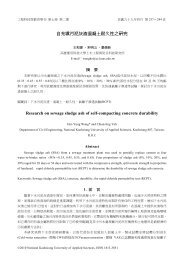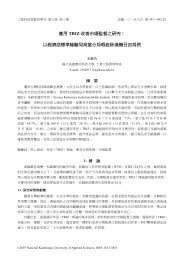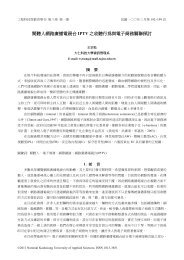Design and Fabrication of Topologically Optimal Miniature ...
Design and Fabrication of Topologically Optimal Miniature ...
Design and Fabrication of Topologically Optimal Miniature ...
Create successful ePaper yourself
Turn your PDF publications into a flip-book with our unique Google optimized e-Paper software.
<strong>Design</strong> <strong>and</strong> <strong>Fabrication</strong> <strong>of</strong> <strong>Topologically</strong> <strong>Optimal</strong> <strong>Miniature</strong> Microgripper Integrated with<br />
an Electro-Thermal Microactuator<br />
167<br />
optimization, we define the design domain firstly, <strong>and</strong> then divide it into a large number <strong>of</strong> finite elements. Next,<br />
optimization theory is used to determine which elements are retained in the design domain. The compliant<br />
mechanism gives optimum shape <strong>and</strong> size when the objective function is minimized. The exhaustive set structural<br />
elements is known as the ground structure.<br />
Some researchers have investigated the application <strong>of</strong> topology optimization to the design <strong>of</strong> integrated<br />
flextensional actuators. Nishiwaki [14] used the homogenization method to maximize deflection in the design <strong>of</strong><br />
integrated flextensional actuators. Silva [15] extended this approach to design coupling structures with a specified<br />
resonant frequency. In a related paper, Silva [16] developed a topological-optimization procedure for designing<br />
composite materials with prescribed piezoelectric <strong>and</strong> mechanical properties. Additionally, Hetrick <strong>and</strong> Kota [17]<br />
have employed a size <strong>and</strong> shape optimization technique to a predetermined topology to obtain high-gain,<br />
stroke-amplifying compliant mechanisms.<br />
2. Compliant Mechanisms<br />
Mechanisms that contain entire or partial motion from the deflections <strong>of</strong> their compliant parts are termed<br />
compliant mechanisms. The compliant mechanisms are the same as the general mechanisms defined by the<br />
transmission <strong>of</strong> the motion, force, or energy. The differences between them replace the links <strong>and</strong> hinges by flexible<br />
material. According to G. K. Ananthasuresh <strong>and</strong> Mary I. Frecker [18], compliant mechanisms should be divided<br />
into two sorts: lumped compliant mechanism; <strong>and</strong> distributed compliant mechanisms. This study chooses the<br />
distributed compliant mechanism for microgripper device design. The reason for utilizing the compliant<br />
mechanism to do this device is because it is just a two dimensional structure, so it is suitable for micro fabrication.<br />
Another reason is it can be designed by specific definitions. Compliance is distributed throughout the entire body.<br />
There are no hinges <strong>and</strong>, therefore, no localized fatigue points. <strong>Design</strong>s can be tailored for specified stiffness or<br />
rigidity <strong>and</strong> yet be flexible enough to allow desired motion. The design procedures are depicted in Figure 1.<br />
The Electro-Thermal<br />
Microactuator<br />
The microgripper<br />
d i<br />
Compliant mechanism<br />
Topology optimization<br />
(Ground Structure<br />
Optimization algorithm<br />
(Sequential Quadratic<br />
Structure analysis<br />
(Finite element method)<br />
Figure 1.<br />
The Procedure <strong>of</strong> <strong>Design</strong> Methods

















